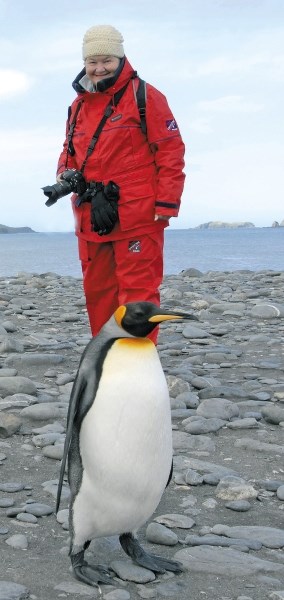There are some creatures that just bring a smile to one’s face and penguins do that for me. They vary in size and colouring but attired in their black and white dinner suits they can’t help but amuse as they hop and waddle about.
Because they only dwell in the wild in the southern hemisphere, I was eager to take an expedition voyage to Antarctica for the opportunity to observe several types of penguins and some of their colonies, which often consist of thousands of birds.
Our voyage on the 100-passenger Russian-built Akademik Sergey Vavilov departed from Ushuaia, Argentina, the southernmost city in the world in January, 2010, their summer season.
My husband and I had chosen the 20 day trip called the “Explorer’s Route” because it focused on the voyages of Shackleton, Perry and Scott as well as the wildlife in the areas we would visit and was a longer voyage with more landings. I can’t describe my eagerness and anticipation as we set sail, venturing into an area where relatively few tourists have travelled.
Our first landing in the Falkland Islands, from a 12-person rubber Zodiac (an inflatable motorized raft), took place on day three of the voyage. With a vivid blue sky and large mounds of brilliant green tussock grass in the background we pulled our craft up on the white sand beach to an audience of Magellanic penguins cavorting in the surf. As we hiked inland we came upon little penguin heads popping out of their burrows in the ground, usually a mom with two or three little ones. They weren’t disturbed by our presence, just a little curious.
Later in the day we disembarked on Saunders Island where we encountered a colony of Gentoo penguins, identified by their bright orange feet and beaks. They came right up to us, pecking at our clothing as we stopped to photograph them.
We walked along the shore and clambered up the hillside to a cliff where Rockhopper penguins mingled with other birds. The cute little tufts of black and yellow feathers atop their heads bobbed as they hopped from rock to rock, endearing them to all their human visitors.
Heading back to the shore on our Zodiac we had our first sighting of King penguins. They are much larger than any of the other penguins we’d seen, the second largest penguin in the world, and measure up to 80 centimetres and weigh up to 15 kilograms. Their colourful bright yellow markings on their beaks, heads and throats and their large size give them a truly regal stature. They resemble the famed Emperor penguins but are smaller. These penguins soon became my favourites. Thank goodness for the continuous shooting mode on my camera because I wanted to capture every pose.
Each zodiac landing produced exciting discoveries. Salisbury Plain in South Georgia was no exception. The astounding sight of masses of King penguins, their colony numbers in this location calculated by scientists to consist of about 250,000 birds, covered the plain. It was a sight to behold.
On closer observation we could see hundreds of chicks in their fluffy brown coats intermingled with the adults. Some were moulting so had patches of sleek black and white adult feathers peeking through the brown fluff. Their loud and raucous squawking did not fit with the harmonious panorama. Amazed, we watched a single adult penguin as it began strutting down to the water, quickly joined by another and another, all following in single file. We watched a male raise his head and voice his loud ecstasy cry (mating call). We also saw mating pairs. This was King penguin heaven.
Gold Harbour provided another bonanza for King penguin viewing; this time an enormous colony of the birds covered the sand against a majestic backdrop of rugged glacier laced mountain peaks. Numerous penguins wandered amongst gigantic female elephant seals and their pups that were lying along the beach, each oblivious to the presence of the other.
In the South Shetland Islands we ventured up a slippery scree slope to a colony of nesting Adelie penguins identified by their black and white colouring and eyes ringed with white. They build nests with circles of rocks. It proved very entertaining to watch their antics as they stole pebbles from another bird’s nest to build their own. Our onboard scientists noted that this colony is much smaller than in previous years but the number of skuas, their predators, has increased.
Our stop at Hannah Point provided our only opportunity to see a Macaroni penguin and one was all we saw. It is another penguin with a tuft of feathers on its head but is distinguished from the Rockhopper by its larger size and orange tuft.
We also saw Chinstraps, a penguin characterized by the thin black line under its beak which looks exactly like a chin strap and gives the appearance of a perpetual grin. It was heartwarming to see several of the mums harbouring their fluffy gray-coated chicks snuggled against their bodies.
During days spent at sea, our onboard scientist experts provided fascinating presentations about the wildlife, history and geography of all the areas we visited. As a result, I learned more about penguins than I’d imagined I would.
The recent opening of the penguin habitat at the Calgary Zoo is exciting because it will give visitors an opportunity to have up close and personal experiences with these delightful birds right at home. There are very few exhibits of this kind and it’s evident from its popularity that Calgarians and tourists are all enjoying the experience. We are now lucky to have a taste of an Antarctic voyage in our own backyard.




